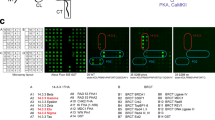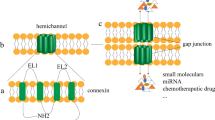Abstract
Gap junctional communication during the progression of cell cycle from quiescent G0 to S phase was examined in cultured clone 9 rat liver cells. The transfer of scrape-loaded fluorescent dye was suppressed immediately after the stimulation of cell cycle progression in a synchronized cell population. Northern blot analysis showed that the temporal disturbance of gap junctional communication in cells passing from G0 to S phase did not result from transcriptional down-regulation of connexin 43. It was also found that the PKC inhibitor, calphostin C, was able to restore intercellular communication in serum stimulated cells. Data suggest a control mechanism by PKC mediated phosphorylation in the regulation of gap junction function which is vulnerable to cell cycling. The loss of gap junctional communication correlated with the increased phosphorylation of connexin 43 on serine residues in clone 9 cells. (Mol Cell Biochem 167: 41-49, 1997)
Similar content being viewed by others
References
Sherr CJ: G1 phase progression cycling on cue. Cell 79: 551–555, 1994
Hunter T, Pines J: Cyclins and cancer II: Cyclin D and CDK inhibitors come of age. Cell 79: 573–582, 1994
Kamb A: Cell-cycle regulators and cancer. Trends Gen 11: 136–140, 1995
Firpo EJ, Koff A, Solomon MJ, Roberts JM: Inactivation of a cdk2 inhibitor during interleukin 2-induced proliferation of human T lymphocytes. Mol Cell Biol 14: 4889–4901, 1994
Kato JY, Matsuoka M, Polyak K, Massague J, Sherr CJ: Cyclic AMP-induced G1 phase arrest mediated by an inhibitor(p27 kjp1 ) of cyclin dependent kinase 4 activation. Cell 79: 487–496, 1994
Li Y, Jenkins CW, Nicols MA, Xiong Y: Cell cycle expression and p53 regulation of the cyclin-dependent kinase inhibitor p21. Oncogene 9: 2261–2268, 1994
Slinngerland JM, Hengst L, Pan CH, Alexander D, Stampfer MF, Reed SI: A novel inhibitor of cyclin-cdk activity detected in transforming growth factor b-arrested epithelial cells. Mol Cell Biol 14: 3683–3694, 1994
Whitaker M, Patel R: Calcium and cell cycle control. Development 108: 525–542, 1990
Colomer J, Lopez-Girona A, Agell N, Bachs O: Calmodulin regulates the expression of cdks, cyclins and replicative enzymes during prolifera-tive activation of human T lymphocytes. Biochem Biophys Res Commun 200: 306–312, 1994
Sewing A, Burger C, Brusselbach S, Schalk C, Lucibello FC, Muller R: Human cyclin D1 encodes a labile nuclear protein whose synthesis is directly induced by growth factors and suppressed by cyclic AMP. J Cell Sci 104: 545–555, 1993
Dunlap K, Takedda K, Brehm P: Activation of a calcium-dependent photoprotein by chemical signaling through gap junctions. Nature 325: 60–62, 1987
Saez JC, Conner JA, Spray DC, Bennett MVL: Hepatocyte gap junctions are permeable to the second messenger, inositol 1,4,5-triphosphate, and to calcium ions. Proc Natl Acad Sci USA 86: 2708–2712, 1989
Kessler JA, Spray DC, Saez JC, Bennett MVL: Determination of synaptic phenotype: Insulin and cAMP independently initiate development of electronic coupling between cultured sympathetic neurons. Proc Natl Acad Sci USA 81: 6235–6239, 1984
Lawrence TS, Beers W H, Gilula N B: Transmission of hormonal stimulation by cell-to-cell communication. Nature 272: 501–506, 1978
Murray SA, Fletcher WH: Hormone-induced intercellular signal transfer dissociates cyclic AMP-dependent protein kinase. J Cell Biol 98: 1710–1719, 1984
Charles AC, Naus CCG, Zhu D, Kidder GM, Dirksen ER, Sanderson MS: Intercellular calcium signaling via gap junctions in glioma cells. J Cell Biol 118: 195–201, 1992
Maldonado PE, Rose B, Lowenstein WR: Growth factors modulate junctional cell-to-cell communication. J Membr Biol 106: 203–210, 1988
Lau AF, Kanemitsu MY, Kurata WE, Danesh S, Boyton AL: Epidermal growth factor disrupts gap-junctional communication and induces phosphorylation of connexin 43 on serine. Mol Biol Cell 3: 865–874, 1992
Hu VW, Xie HQ: Interleukin-αsuppresses gap junction-mediated intercellular communication in human endothelial cells. Exp Cell Res 213: 218–223, 1984
Bergoffen J, Scherer SS, Wang S, Scott MO, Bone LJ, Paul DL, Chen K, Lensch MW, Chance PF, Fischbeck KH: Connexin mutations in X-linked Charcot-Marie-Tooth disease. Science 262: 2039–2042, 1993
Mehta PP, Yamamoto M, Rose B: Transcription of the gene for the gap junctional protein connexin 43 and expression of functional cell-to-cell channels are regulated by cAMP. Mol Biol Cell 3: 839–850, 1992
Bootsma D, Budke L, Vos O: Studies on synchronous division of tissue culture cells initiated by excess thymidine. Exp Cell Res 33: 301–309, 1964
El-Fouly MH, Trosko JE, Chang CC: Scrape-Loading and Dye Transfer: A rapid and simple technique to study gap junctional intercellular communication. Exp Cell Res 168: 422–430, 1987
Rhee YH, Ahn JH, Choe J, Kang KW, Joe CO: Inhibition of mutagenesis and transformation by root extracts of Panax ginseng in vitro. Planta Med 57: 125–128, 1991
Palmiter RD: Magnesium precipitation of ribonucleoprotein complexes. Expedient techniques for the isolation of undegraded polysomes and messenger ribonucleic acid. Biochemstry 13: 3606–3615, 1974
Beyer EC, Paul DL, Goodenough DA: Connexin 43: A protein from rat heart homologous to a gap junction protein from liver. J Cell Biol 105: 2621–2629, 1987
Clackson T, Gussow D, Jones PT: General application of PCR to gene cloning and manipulation. In: MJ McPherson, P Quirke, GR Taylor (eds). PCR a practical approach, IRL Press, Inc., New York, 1991, pp 187–214
Kamps MP: Determination of phosphoamino acid composition by acid hydrolysis of protein blotted to immobilon. In: JN Abelson, MI Simon (eds). Methods Enzymol. Academic Press Inc., San Diego, 1991, vol. 201(B), pp 21–27
Duclos B, Marcandier S, Cozzone AJ: Chemical properties and separation of phosphoamino acids by thin-layer chromatography and/or electrophoresis. In: JN Abelson, MI Simon (eds). Methods Enzymol, Academic Press, Inc., San Diego, 1991, vol. 201(B), pp 10–21
Enomoto T, Sasaki Y, Shiba Y, Kanno Y, Yamasaki H: Tumor promoters cause a rapid and reversible inhibition of the formation and maintenance of electrical cell coupling in culture. Proc Natl Acad Sci USA 78: 5628–5632, 1981
Heussen GAH, Alink GM: Inhibition of gap-junctional intercellular communication by TPA and airborne particulate matter in primary cultures of rat alveolar type II cells. Carcinogenesis 13: 719–722, 1992
Na MR, Koo SK, Kim DY, Park SD, Rhee SK, Kang KW, Joe CO: In vitro inhibition of gap junctional intercellular communication by chemical carcinogens. Toxicology 98: 199–206, 1995
Atkinson MM, Menko AS, Johnson RG, Sheppard JR, Sheridan JD: Rapid and reversible reduction of junctional permeability in cells infected with a temperature-sensitive mutant of avian sarcoma virus. J Cell Biol 91: 573–578, 1981
Vanhamme L, Rolin S, Szpirer C: Inhibition of gap-junctional intercellular communication between epithelial cells transformed by the activated H-ras-1 oncogene. Exp Cell Res 180: 297–301, 1989
Brissette JL, Kumer NM, Gilular NB, Dotto GP: The tumor promoter 12-O-tetradecanoylphorbol-13-acetate and the ras oncogene modulate expression and phosphorylation of gap junction proteins. Mol Cell Biol 11: 5364–5371, 1991
Loo LWM, Berestecky JM, Kanemitsu MY, Lau AF: pp60SRC-mediated phosphorylation of connexin 43, a gap junction protein. J Biol Chem 270: 12751–12761, 1995
Hossain MZ, Bertram JS: Retinoids suppress proliferation, induce cell spreading, and up-regulate connexin 43 expression only in post-confluent 10T1/2 cells: Implications for the role of gap junctional communication. Cell Growth Differ 5: 1253–1263, 1994
Holthuis J, Owen TA, Van Wijnen AJ, Wright KL, Ramskey-Ewing A, Kennedy MB, Carter R, Cosenza SC, Soprano KJ, Lian JB, Stein JL, Stein GS: Tumor cells exhibit deregulation of the cell cycle histone gene promoter factor HiNF-D. Science 247: 1454–1457, 1990
Wright KL, Dell'Orco RT, Van Wijnen AJ, Stein JL, Stein GS: Multiple mechanisms regulate the proliferation-specific histone gene transcription factor HiNF-D in normal human diploid fibroblasts. Biochemistry 31: 2812–2818, 1992
Berthoud VM, Rook MB, Traub O, Hertzberg EL, Saez JC: On the mechanisms of cell uncoupling induced by a tumor promotor phorbol ester in clone 9 cells, a rat liver epithelial cell line. Eur J Cell Biol 62: 384–396, 1993
Lee SW, Tomasetto C, Paul D, Keyomarsi K, Sager R: Transcriptional down regulation of gap-junction proteins blocks junctional communication in human mammary tumor cell lines. J Cell Biol 118: 1213–1221, 1992
Crow DS, Beyer EC, Paul DL, Kobe SS, Lau AF: Phosphorylation of connexin 43 gap junction protein in uninfected and Rous sarcoma virus-transformed mammalian fibroblasts. Mol Cell Biol 10: 1754–1763, 1990
Filson AJ, Azarnia R, Beyer EC, Lowenstein WR, Brugge JS: Tyrosine phosphorylation of a gap junction protein correlates with inhibition of cell-to-cell communication. Cell Growth Differ 1: 661–668, 1990
Swenson KI, Piwnica-Worms H, McNamee H, Paul DL: Tyrosine phosphorylation of the gap junction protein connexin 43 is required for the pp60v-src-induced inhibition of communication. Cell Reg 1: 989–1002, 1990
Munari-Silem Y, Audebet C, Rousset B: Hormonal control of cell to cell communication: Regulation by thyrotropin of the gap junction-mediated dye transfer between thyroid cells. Endocrinology 128: 3299–3309, 1991
Godwin AJ, Green LM, Walsh MP, McDonald JR, Walsh DA, Fletcher WH: In situ regulation of cell-cell communication by the cAMP-de-pendent protein kinase and PKC. Mol Cell Biochem 128: 293–307, 1993
Yada T, Rose B, Lowenstein WR: Diacylglycerol downregulates junctional membrane permeability: TMB-8 blocks this effect. J Membr Biol 88: 217–232, 1985
Kristian Enkvist MO, McCarthy KD: Activation of PKC blocks astroglial gap junction communication and inhibits the spread of calcium waves. J Neurochem 59: 519–526, 1992
Berthoud VM, Ledbetter MLS, Hertzberg EL, Saez JC: Connexin 43 in MDCK cells: regulation by a tumor-promoting phorbol ester and Ca2+. Eur J Cell Biol 57: 40–50, 1992
Moreno AP, Saez JC, Fishman GI, Spray DC: Human connexin 43 gap junction channels: Regulation of unitary conductances by phosphorylation. Circ Res 74: 1050–1057, 1994
Saez JC, Nairn AC, Czernik AJ, Spray DC, Hertzberg EL, Greengard P, Bennett MV: Phosphorylation of connexin 32, a hepatocyte gap-junction protein, by cAMP-dependent protein kinase, protein kinase C and Ca2+ /calmodulin-dependent protein kinase II. Eur J Biochem 192: 263–273, 1990
Kanemitsu MY, Lau AF: Epidermal growth factor stimulates the disruption of gap junctional communication and connexin 43 phosphorylation independent of 12-O-tetradecanoylphorbol 13 acetate-sensitive protein kinase C: The possible involvement of mitogen-activated protein kinase. Mol Biol Cell 4: 837–848, 1993
Asmoto M, Oyamada M, Aoumari AL, Gros D, Yamasaki H: Molecular mechanisms of TPA-mediated inhibition of gap junctional intercellular communication: Evidence for action of the assembly or function but not the expression of connexin 43 in rat liver epithelial cells. Mol Carcinog 4: 322–327, 1991
Enomoto T, Yamasaki H: Rapid inhibition of intercellular communication between BALB/c 3T3 cells by diacylglycerol, a possible endogenous functional analogue of phorbol esters. Cancer Res 45: 3706–3710, 1985
Muir JG, Murray AW: Mimicry of phorbol ester responses by diacylglycerols: Differential effects on phosphatidylcholine biosyn-thesis, cell-cell communication and epidermal growth factor binding. Biochim Biophys Acta 885: 176–184, 1986
Saez JC, Berthoud VM, Moreno AP, Spray DC: Gap junctions: Multiplicity of controls in differentiated and undifferentiated cells and possible functional implications. In: S Shenolikar, AC Nairn (eds). Adv. Second Messenger Phosphoprotein Res., Raven Press Ltd., New York, 1993, vol. 27, pp 163–198
Burns RF, Miller FD, Merriman RL, Howbert JJ, Heath WF, Kobayashi E, Takahashi I, Tamaoki T, Nakano H: Inhibition of protein kinase C by calphostin C is light-dependent. Biochem Biophys Res Comm 176: 288–293, 1991
Author information
Authors and Affiliations
Rights and permissions
About this article
Cite this article
Koo, S.K., Kim, D.Y., Park, S.D. et al. PKC phosphorylation disrupts gap junctional communication at G0/S phase in clone 9 cells. Mol Cell Biochem 167, 41–49 (1997). https://doi.org/10.1023/A:1006831114120
Issue Date:
DOI: https://doi.org/10.1023/A:1006831114120




